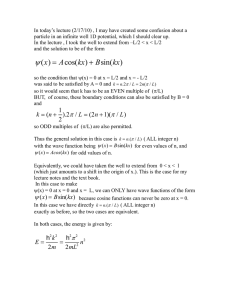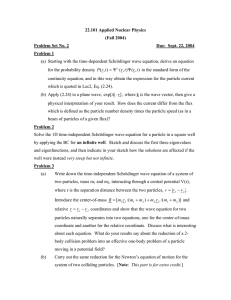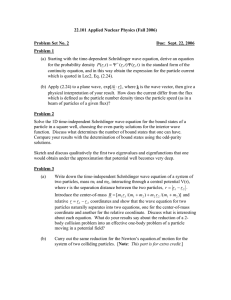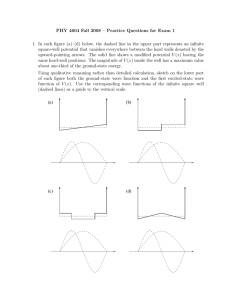π ψ π ψ
advertisement
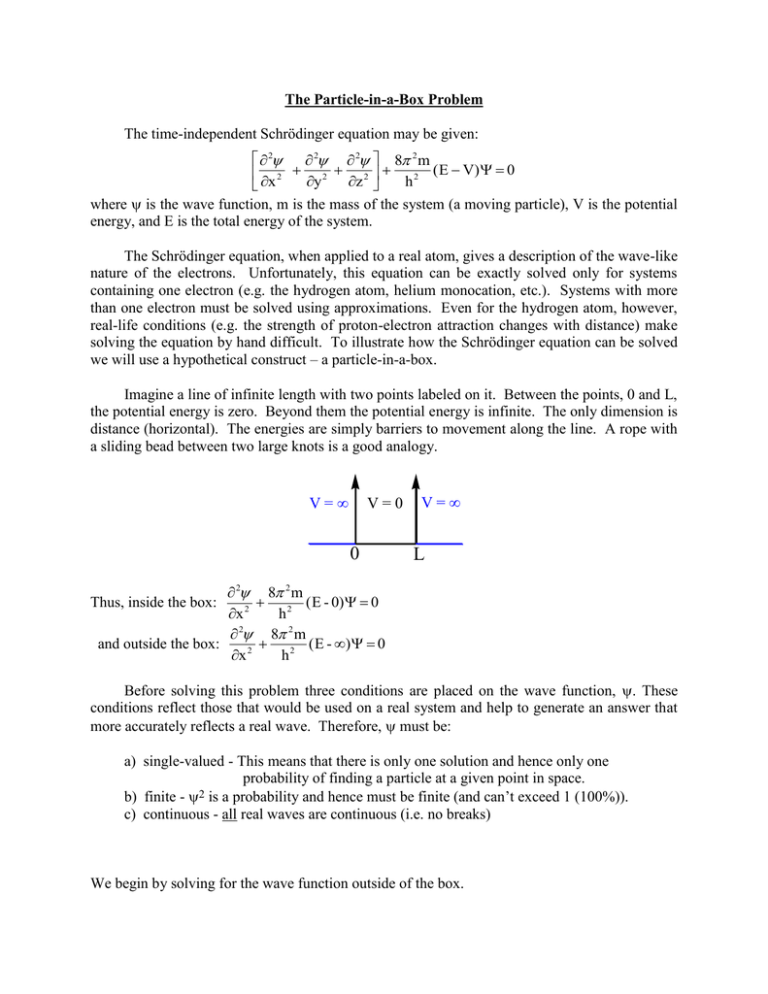
The Particle-in-a-Box Problem The time-independent Schrödinger equation may be given: 2 2 2 8 2 m ( E V) 0 x 2 y 2 z 2 h2 where is the wave function, m is the mass of the system (a moving particle), V is the potential energy, and E is the total energy of the system. The Schrödinger equation, when applied to a real atom, gives a description of the wave-like nature of the electrons. Unfortunately, this equation can be exactly solved only for systems containing one electron (e.g. the hydrogen atom, helium monocation, etc.). Systems with more than one electron must be solved using approximations. Even for the hydrogen atom, however, real-life conditions (e.g. the strength of proton-electron attraction changes with distance) make solving the equation by hand difficult. To illustrate how the Schrödinger equation can be solved we will use a hypothetical construct – a particle-in-a-box. Imagine a line of infinite length with two points labeled on it. Between the points, 0 and L, the potential energy is zero. Beyond them the potential energy is infinite. The only dimension is distance (horizontal). The energies are simply barriers to movement along the line. A rope with a sliding bead between two large knots is a good analogy. V= V=0 0 V= L 2 8 2 m ( E - 0) 0 Thus, inside the box: x 2 h2 2 8 2 m ( E - ) 0 and outside the box: x 2 h2 Before solving this problem three conditions are placed on the wave function, These conditions reflect those that would be used on a real system and help to generate an answer that more accurately reflects a real wave. Therefore, must be: a) single-valued - This means that there is only one solution and hence only one probability of finding a particle at a given point in space. b) finite - 2 is a probability and hence must be finite (and can’t exceed 1 (100%)). c) continuous - all real waves are continuous (i.e. no breaks) We begin by solving for the wave function outside of the box. 2 8 2 m ( E - ) 0 x 2 h2 2 0 x 2 2 x 2 1 2 x 2 =0 Since V = , the wall is too high for the particle to ever escape, so = 0 is what you would expect. There is no wave outside of the box. (i.e. There is zero probability (= 0) of finding the wave/particle outside of the box.) Now let’s look at the wave inside the box. 2 8 2 m E 0 x 2 h2 This is a second-order differential equation of the general form: y" + py' + qy = 0 where p, q = constants and y', y" are the first and second derivates of the function “y,” respectively. To solve this differential equation, a function is needed which meets the condition that the function equals both its first derivative and its second derivative. A function that meets these criteria is y = enx. Assume then Since p = 0: y = enx n2enx + pnenx +qenx = 0 n2 + pn + q = 0 n2 + q = 0 8 2 mE h2 n = ± i(82mEh-2)½ since E > 0 n = i q where q = Because there are two solutions to the quadratic equation, the resulting wave equation has two parts: y = c1en1x + c2en2x. Finally, plug this solution into the wave equation to yield: c1e 8 2 m i 2 E x h c2e 8 2 m -i 2 E x h This function is mathematically identical to: = Acos(82mEh-2)½x + Bsin(82mEh-2)½x Since the function is continuous, at the border between inside and outside of the box (x = 0 or x = L) the wave functions must be equal. Beginning with x = 0, we find: out = in 0 = Acos(82mEh-2)½(0) + Bsin(82mEh-2)½(0) 0 = Acos(0) + Bsin(0) 0 = A(1) + B(0) A=0 Hence: = Bsin(82mEh-2)½x At the other border x = L and: 0 = Bsin[(82mEh-2)½L] 0 = sin[(82mEh-2)½L] Since sin(x) = 0 only when x = 0, ±, ±2, ... (82mEh-2)½L = ±n (n = integer) (Note: A result of this process is that quantization is derived.) But n 0 because then = 0 everywhere and that is a trivial solution. The equation can be further simplified as follows: Square each side: 82mEh-2L2 = n22 E = n2h2/(8mL2) n x Finally: = Bsin( L ) (Note: After normalization B = (2/L)½ If the particle-in-a-box problem is solved for a three-dimensional box, the energy is given by: 2 2 h2 nx2 ny nz E = 8m ( a2 + b2 + c2 ) Something to observe in the above equations is that each dimension results in the generation of a quantum number (i.e. In 3 dimensions there are 3 quantum numbers: nx, ny, and nz.) and this term introduces the degeneracy of energy levels. This is generally true. The solutions to Schrödinger equations are called eigenfunctions. Three interesting things that result from this equation are: a) The probability of finding a particle is a function of both position and energy. In classical (Newtonian) mechanics the probability is equal everywhere and independent of energy. b) In some places the probability of finding the particle is zero! These places are called nodes. Recall this is reasonable in terms of particle/wave duality. c) Only certain energies are allowed and they are related by integral values. Thus quantization can be derived, not just postulated (as was the case in the Bohr atom). Below the first three energy levels of the particle-in-a-box are plotted. n=3 n=2 n=1 0 L A better graphic may be found at: http://en.wikipedia.org/wiki/Particle_in_a_box. August 25, 2014
